Note: If an image ever fails to appear - refresh your page, it really is there
Newfoundland and Labrador
Newfoundland and Labrador, or Terre Neuve et Labrador in French, is the most easterly province of Canada. It comprises of the island of Newfoundland and the mainland of Labrador to the northwest. The name "Newfoundland" comes from the Portuguese Terra Nova (new land). The influence of the early Portuguese exploration can also be seen in the name "Labrador", which comes from the surname of Portuguese explorer João Fernandes Lavrador. Newfoundland and Labrador's capital and largest city is St. John's.
In 1496 John Cabot obtained a charter from English King Henry VII to "sail to all parts, countries and seas of the East, the West and of the North, under our banner and ensign and to set up our banner on any new-found-land." Although Cabot's exact point of landing is unclear, tradition claims that he landed either at Cape Bonavista or Cape Breton Island on June 24, 1497. We can say with certainly that 86 years later, in 1583, armed with letters patent from Queen Elizabeth I, Sir Humphrey Gilbert landed in St. John's and formally took possession of the island.
Prior to the arrival of the English explorers, Newfoundland and Labrador had several earlier waves of visitors, most notably starting with the Vikings, who were followed by the Portuguese and French. Below we visit some of the flags that have once flown over the land and area of today's Canadian Province of Newfoundland and Labrador.
Flags over Newfoundland and Labrador
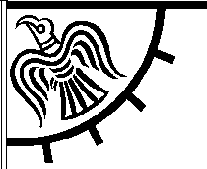
The Guðfani
|
The Raven Banner c800
Archaeological evidence of a Norse settlement was found in L'Anse aux Meadows on Newfoundland. It is very unlikely that the Viking explorers used any flags at all. Since the Vikings left few writing records of their explorations except those found in the famous Norse Sagas where no flags were mentioned. However, the Raven Banner (Guðfani) is the most commonly reported Norse "flag" and it is possible that it might have been brought to Newfoundland. We do know that Viking explorers like Bjarni Herjulfesson, Helge Ingstad, Eric the Red, and Leif Ericsson all played a part in the early exploration of Newfoundland between AD 800-1000, but again there is no historical documentation to support the assumption that Raven Banner or any other flag was used.
Most flag historians believe the Guðfani banner was not a banner, but a semi-circular metal vexilla ornamented with streamers. It was actually a metal wind vane used on ships to gauge the direction and strength of the wind. The "tails" were narrow ribbons attached to it to give early indication of wind changes.
|

Irish Flag
|
The Irish Explorers
There is a fantastical account of an Irish monk named Saint Brendan the Navigator who made a sea voyage in the early 6th century to Newfoundland from Ireland. While the story itself is a part of Irish myth and legend, some historians believe it is based on fact.
It is of interest that in 1970s an adventurer named Tim Severin was able to successfully replicate Saint Brendan's journey in a leather boat, thus proving that the voyage could have happened as legend claims. |

Portuguese Flag
|
The Portuguese
Portuguese explorers were active in Canadian waters throughout 1600s. In 1501 and 1502, Portuguese brothers Miguel and Gaspar Corte-Real explored Newfoundland and Labrador, claiming them as part of the Portuguese Empire.
In 1506, King Manuel I of Portugal created taxes for the cod fisheries in Newfoundland waters. João Álvares Fagundes and Pêro de Barcelos established seasonal fishing outposts in Newfoundland and Nova Scotia around 1521, and older Portuguese settlements may have existed.
|

Fleur-de-lis Banner

French Blue Flag
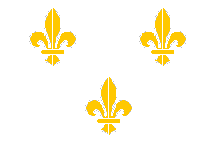
French White Flag
|
The French Fisheries
Newfoundland has always been called "England's oldest colony" in Canada based on the arrival of John Cabot in 1497 and Sir Humphrey Gilbert's claim in 1583, but from the very beginning, France was also an important participant in the exploration and exploitation of Newfoundland. Although the French explorer Jacques Cartier arrived in 1534, Breton, Norman and Basque fishermen had already been fishing in Newfoundland's waters for over thirty years.
At first, the French fishermen concentrated on fishing close to shore in open boats. But by the middle of the 1500s, the French were also fishing on the offshore banks. This would remained so well into the 19th century fulfilling a need for fish for both the domestic and international French markets. It was the ability of the Labrador and Newfoundland fishing grounds to provide a rich variety of fish that contributed to the longevity and continued French presence in Newfoundland.
French fishermen could be found in many parts of Newfoundland. The southern half of Newfoundland, from Cape Race west beyond Placentia Bay, was one region heavily populated by the French. The French colony at Placentia (Plaisance) was established in 1662 along with numerous other tiny settlements in the area. The region along the coast north of Bonavista and particularly the coast of the Northern Peninsula came to be called the Petit Nord, or the "French Shore." A third region was the western coast of Newfoundland is where the French Basques made their own special domain. In the 17th-century Newfoundland was actually more French than it was English. Even today in St. Pierre and Miquelon, one finds remnants of the French settlements still listed as an overseas department of France. |

NNS Flag 1852
First Flag of Newfoundland?
|
Newfoundland Natives' Society 1840-c1860
The Newfoundland Natives' Society (NNS), a non-denominational organization founded in 1840 "to protect the rights and privileges of Newfoundland-born citizens against the flood of newcomers to the island in the mid-nineteenth century", provided Newfoundland with one of its earliest versions of a "native" tricolor flag. The NNS's first silk flag (not shown) is clearly documented. It had a elaborate shield centered on it depicting aspects of Newfoundland life. There were clasped hands above the shield and the words "Union and Philanthropy" below it. The whole flag had a red background.
This original red silk flag was replaced at some time before 1852 with this red, white and green tricolor, these being the official colors of the Society. These Red-White-Green flags were displayed at NNS events throughout the 1850s-1860s. It was this tricolor, the Native red, white and green flag, that became the first widely recognized and unique flag of Newfoundland, and many now accept this as the first flag of Newfoundland. |
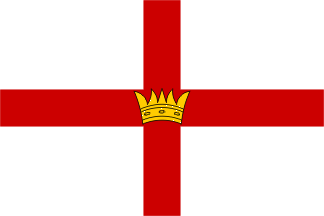
Governor's flag c1862
|
Government House Flag c1862
Although the usual flag to fly on the Government House in St. John's would probably have been the Union Jack, this flag was shown on the Government House in a book of water-colors made in 1862 called The "Corrected Code of Merchant's Signals". It was most likely a "Governor's Flag" used in the 1860s before the introduction of the defaced Union Jacks in 1870.
In 1870 one Royal Governor wrote to the Colonial Office saying he would discontinue use of the old Governor's Flag which was described as "a St. George's Cross with crown in the center on a white ground", most likely referring to a flag similar as shown here.
|
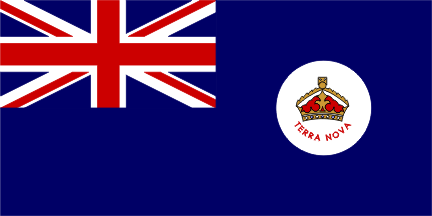
Governor's flag c1870
|
Governor's Flag 1870
Another variant of the Governor's Flag appearing around 1870 was basically a blue British ensign defaced with a simple white circular shield with the words "Terra Nova" (new land) written in red beneath a royal crown. The only official reference found to these pre-1870 governor's flags was in the 1862 edition of "Queen's Regulations & Admiralty Instructions". It was found in the section dealing with Ceremonial and Distinctions and was included with a Colonial Office Circular of 17 Oct 1862. V-4.
|
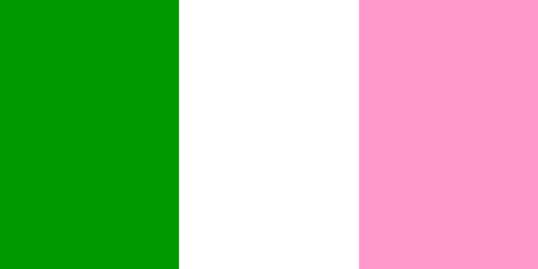
Green, White, and Pink Flag c1880
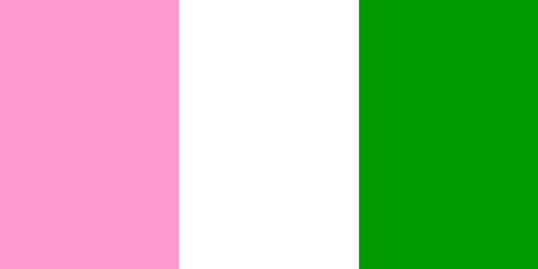
Pink, White and Green Flag c1880
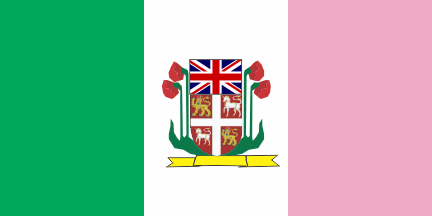
Green, White, and Pink variant c1901
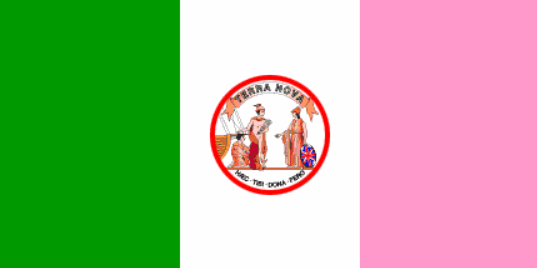
Green, White and Pink
Protest flag 2005
|
The Newfoundland Tricolor c1880
The flag commonly presented as the Newfoundland Tricolor, or the "Green, White and Pink", is a traditional flag very popular in the Newfoundland and Labrador area, but has never been "officially" recognized in any way by the government. Popular tradition claims it was originated in the 1880s or 1890s as the flag of a Roman Catholic fraternal group named "The Star of the Sea Association" (founded 1871) in St. John's. It is one of the few recognized flags in the world to use the color pink (occasionally called rose) in its design. Many times, although normally displayed in a "Green, White, & Pink" pattern, it also is mirrored or reversed into a "Pink, White, & Green": pattern.
Popular local legend says that the flag was created in 1843 by Bishop Michael Fleming as an attempt to bring peace between local competing Protestants and Catholics. Apparently the two groups competed to supply wood to the local churches, schools and other charity institutions. The Protestant English marked their wood piles the rose flag of the Natives Society, while the Catholic Irish used green banners. The threat of violence was such that the Speaker of the House, William Carson, suggested that Bishop Fleming should be enlisted as a peacemaker. Bishop Fleming persuaded the two factions to adopt a common flag, tying together the rose and green flags of the two groups with a white centerband, which was to symbolize peace. This story is based on oral tradition with no actual historical evidence to support it.
Although the origins of the flag are not clear, it has become a popular regional flag with wide usage. Over the years variant versions have defaced the original design by adding shield and symbols, usually in the center white band as illustrated in the variants added here. The first variant shown comes from the cover of the 1984 Encyclopedia of Newfoundland. It was also pictured earlier in the first edition cover of the sheet music of the "Ode to Newfoundland", an alternative Newfoundland "national" anthem written by Sir Charles Cavendish Boyle in 1901.
The second variant appeared after a political controversy in Newfoundland, when the Premier ordered the removal of the national flag from government offices for a while, and since then has been seen displayed around the island. The badge used on it is from the Newfoundland Red and Blue Ensigns of 1904. . |
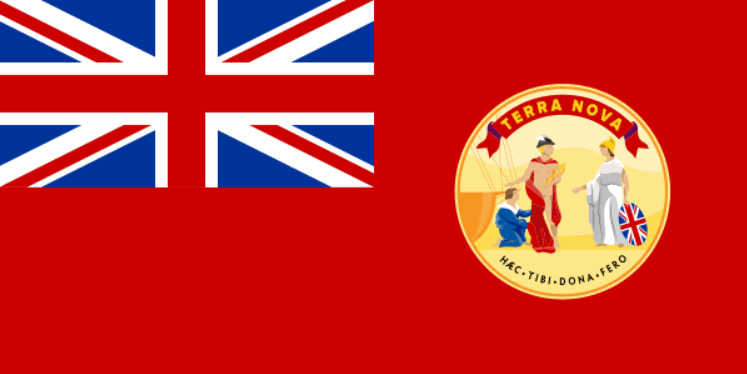
Red Ensign 1904

Blue Ensign 1904
|
The Newfoundland Red and Blue Ensigns 1904-1965
The Red Ensign was officially endorsed by King Charles II in 1674; this authorization recognized it as the ensign of English merchant shipping. Later, during the Victorian era, the flag with colonial badge formed the basis as the Colony of Newfoundland's civil ensign.
The Red and Blue Ensigns with the Great Seal of Newfoundland in the fly were the dominion's official flags from 1904 until 1931, after which the Union Jack was adopted as Newfoundland's official national flag and the ensigns reserved for shipping and marine identification - the Red Ensign to be flown by merchant shipping while the blue was flown by governmental ships.
The badge in the ensigns consists of Mercury, the god of commerce and merchandise, presenting to Britannia a fisherman who, in a kneeling attitude, is offering the harvest of all the sea. Above the device in a scroll are the Latin words Terra Nova, and below the motto Hæc Tibi Dona Fero or "These gifts I bring thee." The seal was redesigned by Adelaine Lane, niece of Governor Sir Cavendish Boyle. |
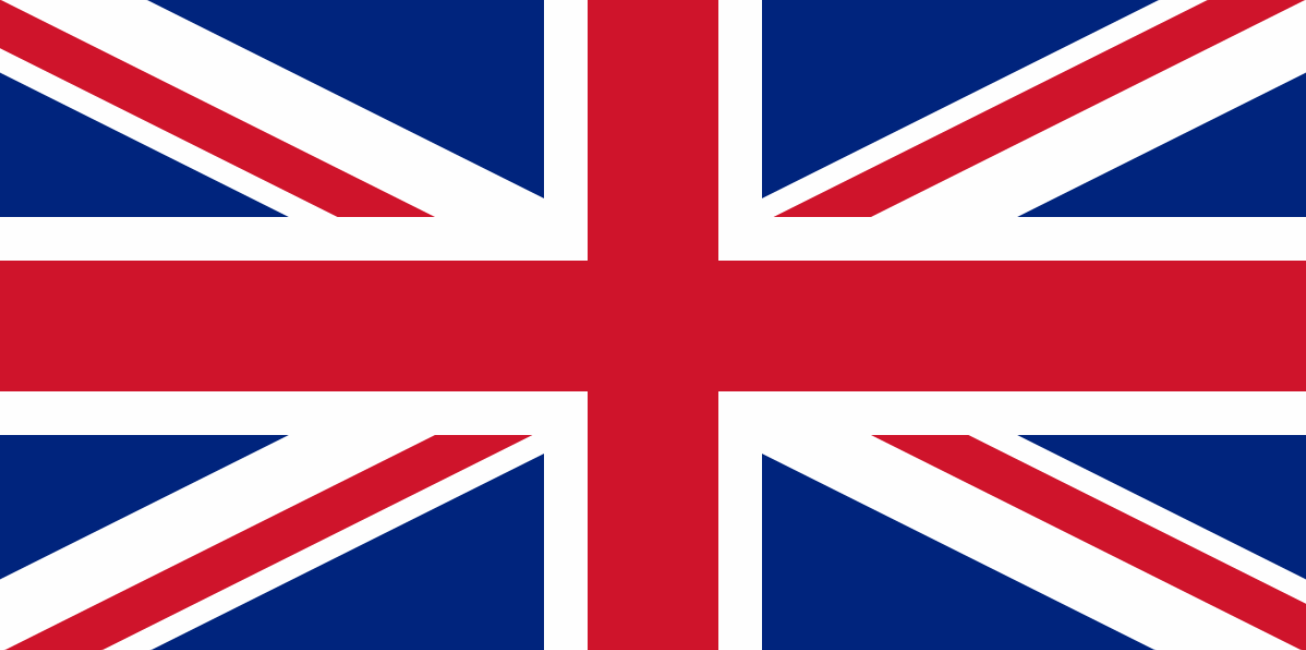
Union Jack 1952
|
The National Flag of Newfoundland 1952-1980
From 1931 until confederation with Canada in 1949 the Union Jack was legislated as the national flag of Newfoundland. Then from 1952 until 1980 the Union Jack was readopted as the official flag of the province of Newfoundland. Ottawa's refusal to recognize the Union Jack as a unique representation of the province led to the provincial government seeking a new Newfoundland flag and the eventual design and adoption of Christopher Pratt's deconstructed Union Jack-based design as the Flag of Newfoundland and Labrador on May 28, 1980. |
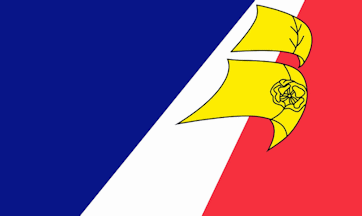
Franco-Terreneuviens Flag
|
The Flag of Franco-Terreneuviens
The flag of the Fédération des Francophones de Terre-Neuve et du Labrador is based on the French tricolor and Acadian flag, with three unequal panels of blue, white, and red. Two yellow sails are set on the line between the white and red panels. The sail on top is charged with a spruce twig, while the bottom sail is charged with a pitcher flower. These emblems are outlined in black.
The sails represent early Basque, Breton, and French fishermen that came to the area in 1504. At the same time, they are symbols of action and progress. The yellow is taken from the star of the Acadian flag. The spruce twig is the emblem of Labrador and is also found on the Labrador flag. Newfoundland and Labrador's provincial flower is the insect-eating pitcher plant.
|
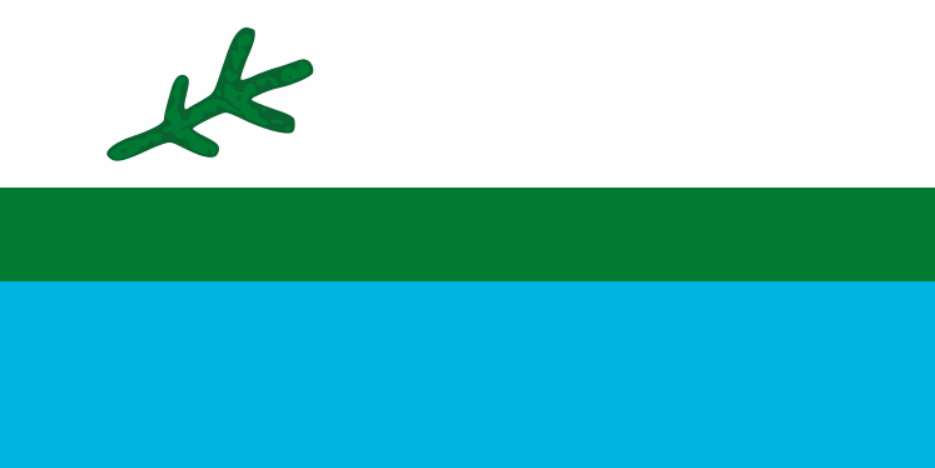
Labrador
|
The Flag of Labrador 1974
The Labrador Flag was created by the Member of the House of Assembly for Labrador South, Mike Martin in 1974. Martin did so as an affront of political mischief aimed at Joey Smallwood and his indifference to Labrador. As Martin is from Cartwright, the town now proclaims itself the "Birthplace of the Labrador Flag".
The flag was presented to Labrador community councils, and to the Labrador members of the House of Assembly, in April 1974. |
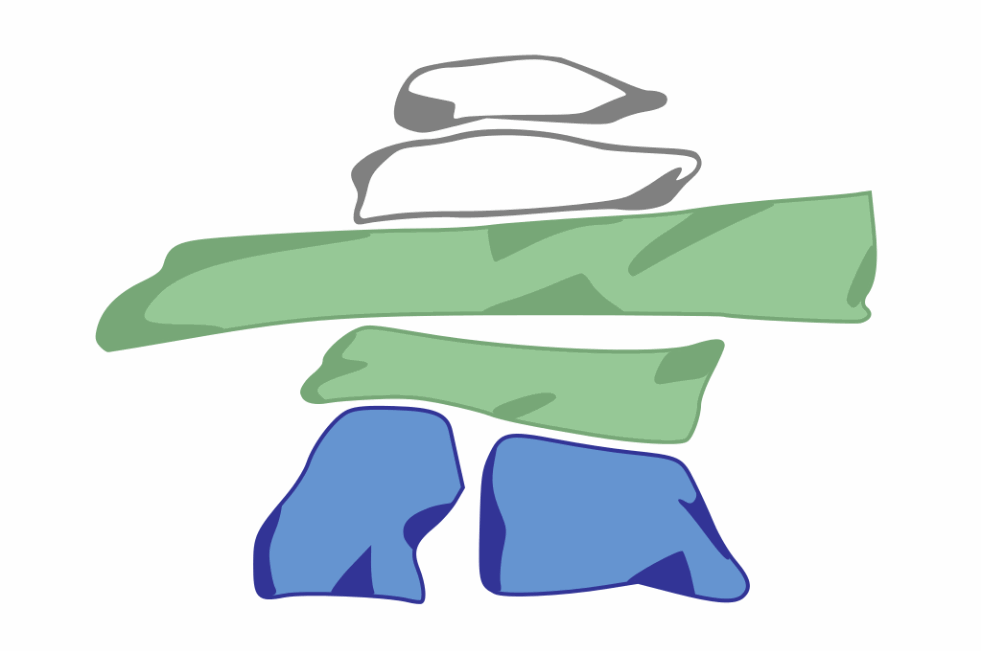
Flag of Nunatsiavut
|
The Flag of Nunatsiavu
Labrador's name in the Inuttitut language (spoken in Nunatsiavut) is Nunatsuak, meaning "the big land" (a common English nickname for Labrador). Newfoundland's Inuttitut name is Ikkarumikluak meaning "place of many shoals".
The self-governing Inuit region of Nunatsiavut uses this flag. The flag features the traditional Inuit Inukshuk colored white, blue, and green echoing the flag of Labrador shown above.
|
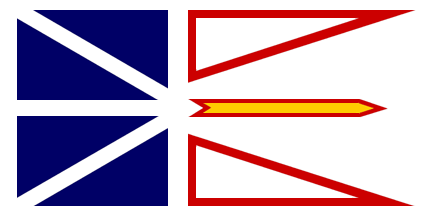
Newfoundland Flag
|
The Flag of Newfoundland and Labrador 1980
As a former colony and then dominion of the United Kingdom, Newfoundland gave up its independence in 1933. It became the tenth province to enter the Canadian Confederation on March 31, 1949, as "Newfoundland." On December 6, 2001, an amendment was made to the Constitution of Canada to change the province's official name to "Newfoundland and Labrador."
In 1980, a Newfoundland artist named Christopher Pratt, designed this flag for a special flag committee that had been selected to find a new design for Newfoundland and Labrador. Ultimately it was chosen by the House of Assembly, then was given royal assent in June of 1980, and raised for the first time on June 24, Discovery Day, the anniversary of the arrival in Newfoundland of John Cabot in 1497.
|
- My thanks to Rob Raeside for all his expert help and advice on this page -
| Top of Page | Return to the Canadian Provinces and Territories Page |
|
|